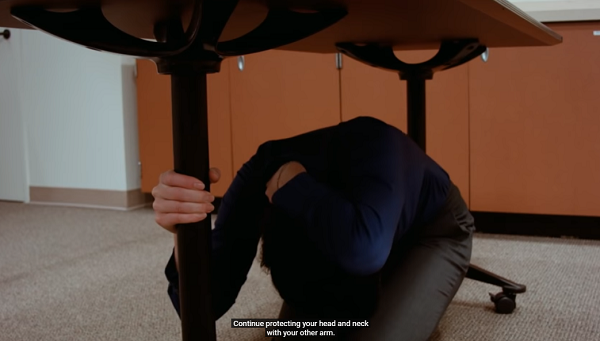
VIDEO: What you should do during an earthquake
If you are INDOORS -- STAY THERE! Get under a desk or table and hang on to it (Drop, Cover, and Hold on!) or move into a hallway or against an inside wall. STAY CLEAR of windows, fireplaces, and heavy furniture or appliances.
GET OUT of the kitchen, which is a dangerous place (things can fall on you). DON'T run downstairs or rush outside while the building is shaking or while there is danger of falling and hurting yourself or being hit by falling glass or debris.
Advertisement
The main point is to not try to move but to immediately protect yourself as best as possible where you are. Earthquakes occur without any warning and may be so violent that you cannot run or crawl; you, therefore, will most likely be knocked to the ground where you happen to be. You will never know if the initial jolt will turn out to be the start of the big one. You should Drop, Cover, and Hold On immediately!
In addition, studies of injuries and deaths caused by earthquakes in the U.S. over the last several decades indicate that you are much more likely to be injured by falling or flying objects (TVs, lamps, glass, bookcases, etc.) than to die in a collapsed building. Drop, Cover, and Hold On offers the best overall level of protection in most situations.
As with anything, practice makes perfect. To be ready to protect yourself immediately when the ground begins to shake, practice Drop, Cover, and Hold On.
In MOST situations, you will reduce your chance of injury if you:
DROP where you are, onto your hands and knees. This position protects you from being knocked down and also allows you to stay low and crawl to shelter if nearby.
COVER your head and neck with one arm and hand.
- If a sturdy table or desk is nearby, crawl underneath it for shelter
- If no shelter is nearby, crawl next to an interior wall (away from windows)
- Stay on your knees; bend over to protect vital organs
HOLD ON until shaking stops
Under shelter: hold on to it with one hand; be ready to move with your shelter if it shifts
No shelter: hold on to your head and neck with both arms and hands.
If you are OUTSIDE -- get into the OPEN, away from buildings, power lines, chimneys, and anything else that might fall on you.
If you are DRIVING -- stop, but carefully. Move your car as far out of traffic as possible. DO NOT stop on or under a bridge or overpass or under trees, light posts, power lines, or signs. STAY INSIDE your car until the shaking stops. When you RESUME driving, watch for breaks in the pavement, fallen rocks, and bumps in the road at bridge approaches.
If you are in a MOUNTAINOUS AREA -- watch out for falling rock, landslides, trees, and other debris that could be loosened by quakes.
What NOT to do:
DO NOT get in a doorway! An early earthquake photo is a collapsed adobe home with the door frame as the only standing part. From this came our belief that a doorway is the safest place to be during an earthquake. In modern houses and buildings, doorways are no safer, and they do not protect you from flying or falling objects. Get under a table instead!
DO NOT run outside! Trying to run in an earthquake is dangerous, as the ground is moving and you can easily fall or be injured by debris or glass. Running outside is especially dangerous, as glass, bricks, or other building components may be falling. You are much safer to stay inside and get under a table.
DO NOT believe the so-called "triangle of life"! In recent years, an e-mail has circulated which recommends potentially life-threatening actions, and the source has been discredited by leading experts.




